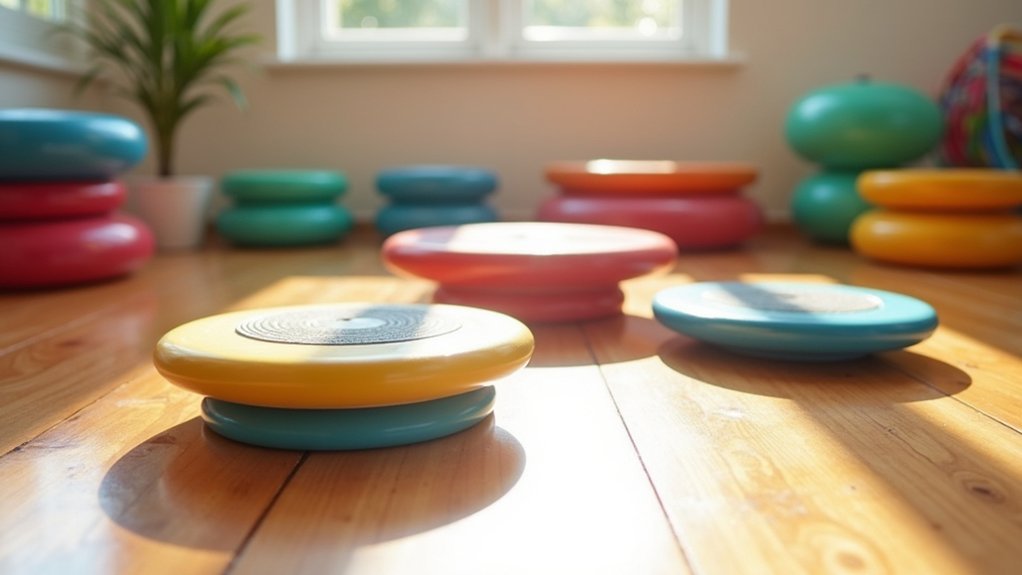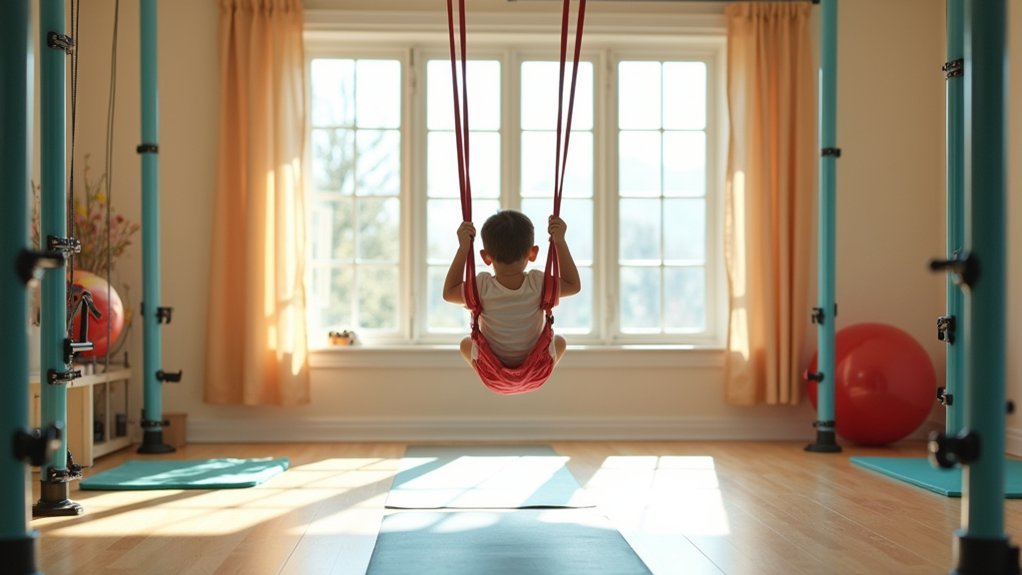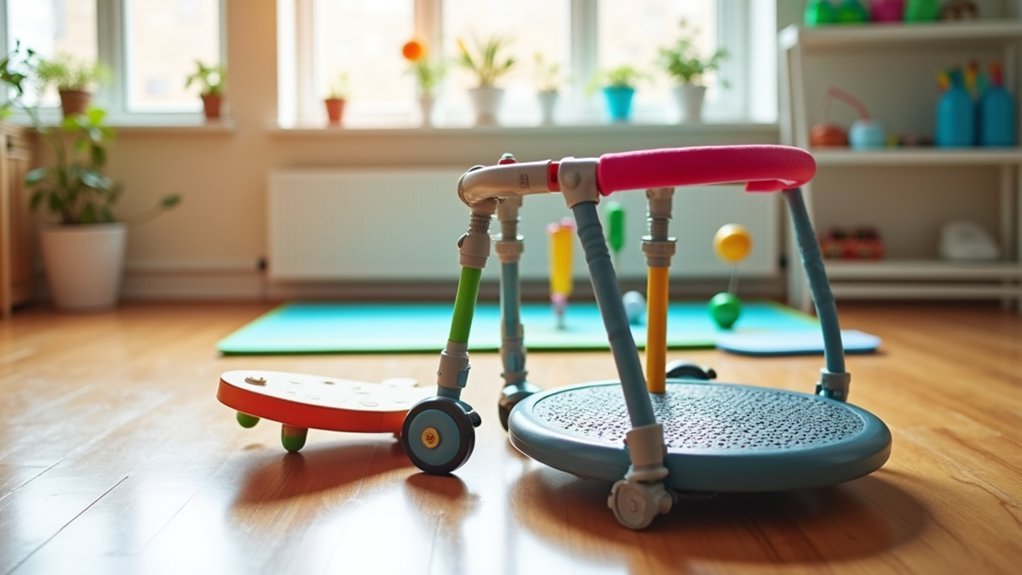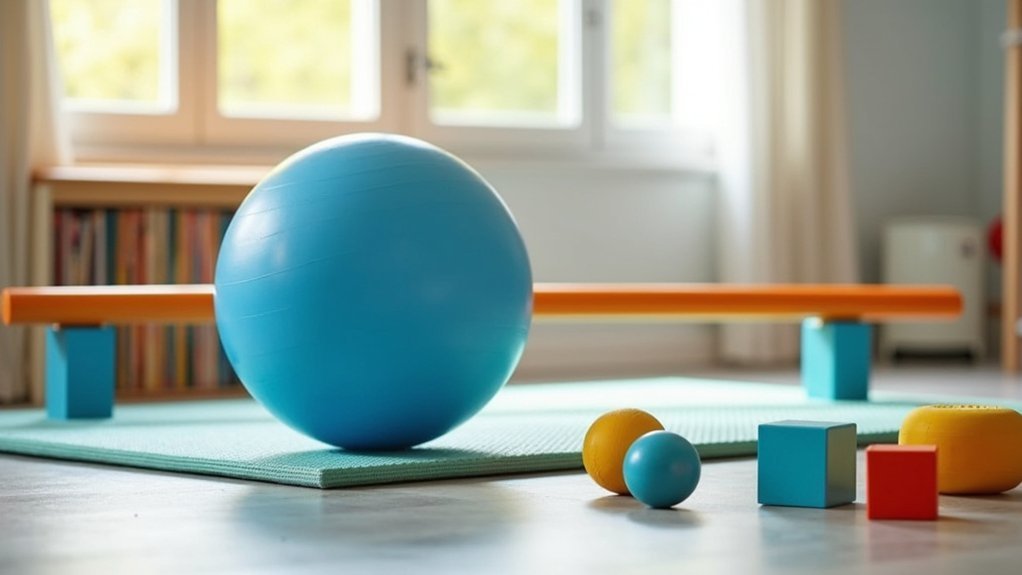Essential balance equipment for cerebral palsy therapy includes balance boards and stability platforms that build motor skills, therapeutic exercise balls for core strength, suspension systems that provide safe movement practice, sensory integration tools for coordination, and adaptive mobility aids with balance features. You’ll want equipment that adjusts to your child’s progress and specific needs. These tools work together to improve posture, prevent falls, and enhance overall mobility while supporting neuroplasticity development.
Balance Boards and Stability Platforms for Motor Skill Development

When working with children who’ve cerebral palsy, balance boards and stability platforms serve as foundational tools for developing essential motor skills.
These devices challenge your child to maintain equilibrium, engaging multiple muscle groups and improving postural stability vital for daily activities.
You’ll notice these tools promote weight-bearing activities that enhance body awareness, helping prevent falls while encouraging safe movement practice.
Balance boards are particularly effective for building core strength and coordination, which directly translate to improved mobility.
Most stability platforms offer adjustable difficulty levels, letting you tailor challenges to your child’s specific therapy goals.
Therapeutic Exercise Balls and Physio Rolls for Core Strengthening
Because core strength forms the foundation of all movement, therapeutic exercise balls and physio rolls have become vital tools in cerebral palsy therapy.
These versatile equipment pieces encourage active engagement while enhancing balance and stability through dynamic positioning.
Physio rolls offer superior trunk control opportunities during rolling and sitting activities, improving postural alignment essential for developing motor skills.
You’ll notice increased muscle activation and coordination as your child practices repetitive movements, supporting neuroplasticity development.
You can customize both tools in size and firmness to match your child’s specific needs, ensuring ideal support during therapy sessions.
With regular use, you’ll see improvements in functional mobility and confidence, allowing your child to participate more fully in daily activities.
This personalized approach transforms exercise into meaningful progress that enhances overall quality of life.
Suspension Systems and Body Weight Support Equipment

Three key components make suspension systems and body weight support equipment essential for cerebral palsy therapy. First, they provide vital safety and confidence by reducing fall risks while supporting walking exercises. Second, these systems distribute weight evenly through harnesses, enhancing muscle activation without full impact. Third, they’re fully adjustable for personalized therapy that evolves with progress.
| System Type | Primary Benefit | Ideal Setting |
|---|---|---|
| Overhead Track | Improves gait mechanics | Physical therapy clinics |
| Mobile Frames | Enhances overall mobility | Home environments |
| Partial Weight Systems | Increases engagement and motivation | Rehabilitation settings |
You’ll find these systems particularly effective as research shows they markedly improve movement outcomes for children with movement disorders while making therapy sessions more enjoyable and productive.
Sensory Integration Tools for Coordination Enhancement
Sensory integration tools represent a critical component in extensive cerebral palsy therapy by simultaneously stimulating multiple body systems.
Balance boards and therapy balls provide invaluable proprioceptive and vestibular input, challenging your child’s coordination while improving muscle tone and postural control through repetitive practice.
You’ll notice enhanced motor planning and body awareness as these tools become regular parts of therapy sessions.
Weighted vests deliver consistent pressure that helps your child feel more grounded during movement activities, while textured mats provide additional sensory feedback for better coordination.
Research consistently shows that children using these specialized tools develop better functional movement skills that transfer to daily activities.
Adaptive Mobility Aids With Balance-Training Features

While traditional mobility devices focus primarily on movement assistance, adaptive mobility aids with balance-training features serve a dual purpose for your child with cerebral palsy. These specialized mobility aids encourage weight-bearing and body weight shifting, crucial skills for walking development.
| Device Type | Key Benefits | Safety Features |
|---|---|---|
| Gait Trainers | Promotes muscle and bone strength | Built-in harness systems |
| Standing Power Wheelchairs | Enables social inclusion at eye level | Secure positioning supports |
| Dynamic Standers | Prevents leg contractures | Adjustable stability controls |
You’ll notice improved stability and confidence as your child uses these devices regularly. Gait trainers with balance-training features provide a secure environment to practice movement without fear of falls. Beyond basic mobility improvement, these adaptive aids foster independence in daily activities by allowing your child to explore their environment safely while developing essential balance skills.
Frequently Asked Questions
What Are the Assistive Equipment for Cerebral Palsy?
You’ll need mobility aids (wheelchairs, walkers), communication devices, adaptive utensils, specialized seating, orthotics, and home modifications. These tools enhance your child’s independence and improve their quality of life with cerebral palsy.
What Type of Equipment Is Used to Treat Cerebral Palsy?
You’ll find various equipment for cerebral palsy treatment including mobility aids (wheelchairs), gait trainers, adaptive seating systems, communication devices (AAC tools), and therapeutic tools like therapy balls and balance boards.
What Postural Equipment Is Needed for Cerebral Palsy?
For cerebral palsy, you’ll need specialized seating systems, standing frames, gait trainers, and adaptive cushions to support proper alignment. These tools help you prevent deformities while improving stability, comfort, and independent mobility during daily activities.
How Can I Improve My Cerebral Palsy Balance?
You’ll improve your cerebral palsy balance by using stability balls, balance boards, and gait trainers regularly. Work with your physical therapist to create a personalized program that incorporates visual feedback and weight-bearing exercises.
In Summary
You’ve now discovered the essential balance equipment that can transform your child’s cerebral palsy therapy. Whether you’re starting with simple balance boards or advancing to suspension systems, you’ll see improvement in their stability, confidence, and independence. Remember, it’s not about having every piece of equipment—it’s about finding what works for your child’s specific needs and integrating it consistently into their therapy routine.





Leave a Reply